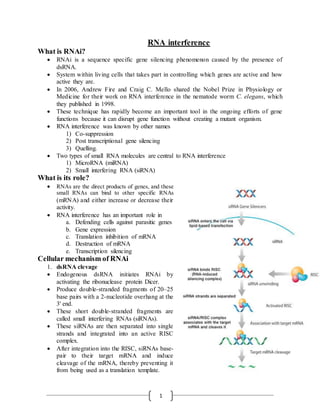
Rna i[2]
- 1. 1 RNA interference What is RNAi? RNAi is a sequence specific gene silencing phenomenon caused by the presence of dsRNA. System within living cells that takes part in controlling which genes are active and how active they are. In 2006, Andrew Fire and Craig C. Mello shared the Nobel Prize in Physiology or Medicine for their work on RNA interference in the nematode worm C. elegans, which they published in 1998. These technique has rapidly become an important tool in the ongoing efforts of gene functions because it can disrupt gene function without creating a mutant organism. RNA interference was known by other names 1) Co-suppression 2) Post transcriptional gene silencing 3) Quelling. Two types of small RNA molecules are central to RNA interference 1) MicroRNA (miRNA) 2) Small interfering RNA (siRNA) What is its role? RNAs are the direct products of genes, and these small RNAs can bind to other specific RNAs (mRNA) and either increase or decrease their activity. RNA interference has an important role in a. Defending cells against parasitic genes b. Gene expression c. Translation inhibition of mRNA d. Destruction of mRNA e. Transcription silencing Cellular mechanism of RNAi 1. dsRNA clevage Endogenous dsRNA initiates RNAi by activating the ribonuclease protein Dicer. Produce double-stranded fragments of 20–25 base pairs with a 2-nucleotide overhang at the 3' end. These short double-stranded fragments are called small interfering RNAs (siRNAs). These siRNAs are then separated into single strands and integrated into an active RISC complex. After integration into the RISC, siRNAs base- pair to their target mRNA and induce cleavage of the mRNA, thereby preventing it from being used as a translation template.
- 2. 2 2. MicroRNAs / stRNAs MicroRNAs (miRNAs) are genomically encoded non-coding RNAs that help in regulating gene expression, particularly during development. The phenomenon of RNA interference, includes the endogenously induced gene silencing effects of miRNAs as well as silencing triggered by foreign dsRNA. Mature miRNAs are structurally similar to siRNAs produced from exogenous dsRNA, but before reaching maturity, miRNAs must first undergo extensive post-transcriptional modification. An miRNA is expressed from a much longer RNA-coding gene as a primary transcript known as a pri-miRNA which is processed, in the cell nucleus, to a 70-nucleotide stem- loop structure called a pre-miRNA by the microprocessor complex. Complex consists of an RNase III enzyme called Drosha and a dsRNA-binding protein Pasha. The dsRNA portion of this pre-miRNA is bound and cleaved by Dicer to produce the mature miRNA molecule that can be integrated into the RISC complex; thus, miRNA and siRNA share the same cellular machinery downstream of their initial processing.
- 3. 3 3. RISC activation and catalysis The active components of an RNA-induced silencing complex (RISC) are endonucleases called argonaute proteins, which cleave the target mRNA strand complementary to their bound siRNA. As the fragments produced by dicer are double-stranded, they could each in theory produce a functional siRNA. However, only one of the two strands, which is known as the guide strand, binds the argonaute protein and directs gene silencing. The other anti-guide strand or passenger strand is degraded during RISC activation. Argonaute proteins, the catalytic components of RISC, are localized to specific regions in the cytoplasm called P-bodies (also cytoplasmic bodies or GW bodies), which are regions with high rates of mRNA decay; miRNA activity is also clustered in P-bodies. Disruption of P-bodies decreases the efficiency of RNA interference, suggesting that they are the site of a critical step in the RNAi process. 4. Transcriptional silencing Components of the RNA interference pathway are also used in many eukaryotes in the maintenance of the organization and structure of their genomes. Modification of histones and associated induction of heterochromatin formation serves to downregulate genes pre-transcriptionally; this process is referred to as RNA-induced transcriptional silencing (RITS), and is carried out by a complex of proteins called the RITS complex. The mechanism by which the RITS complex induces heterochromatin formation and organization is not well understood. In maintenance of existing heterochromatin regions, RITS forms a complex with siRNAs complementary to the local genes and stably binds local methylated histones, acting co- transcriptionally to degrade any nascent pre-mRNA transcripts that are initiated by RNA polymerase. 5. Crosstalk with RNA editing The type of RNA editing that is most prevalent in higher eukaryotes converts adenosine nucleotides into inosine in dsRNAs via the enzyme adenosine deaminase (ADAR).
- 4. 4 It was originally proposed in 2000 that the RNAi and A→I RNA editing pathways might compete for a common dsRNA substrate. Indeed, some pre-miRNAs do undergo A→I RNA editing, and this mechanism may regulate the processing and expression of mature miRNAs. Applications of RNAi It serves as an antiviral defense mechanism. It is becoming a powerful and is widely used tool for the analysis of gene functions in invertebrate, plants and mammals. DNA vector-based strategy allows the suppressions of endogenous gene to produce transgenic lines with suitably modified traits. Several experiments in which crop plants have been improved using RNAi transgenes are: Plant height in rice by interfering with gibberellins metabolism. Changing the glutelin content of rice grains. Controlling the development of leaves. Production of coffee plants that make decaffeinated coffee by using RNAi to suppress caffeine biosynthesis. Precursors of likely carcinogens in tobacco plants. Used to produce cotton stocks whose seeds contain reduced levels of delta-cadinene synthase, a key enzyme in gossypol production, without affecting the enzyme's production in other parts of the plant Oil content of cotton seeds Reduced the levels of allergens in tomato plants Reduction of the cyanogenic natural product linamarin in cassava plants. Other plant traits that have been engineered in the laboratory include Production of non-narcotic natural products by the opium poppy. Fortification of plants such as tomatoes with dietary antioxidants. Previous commercial products, including the Flavr Savr tomato and two cultivars of ringspot-resistant papaya, were originally developed using antisense technology but likely exploited the RNAi pathway. Resistance to common plant viruses.
